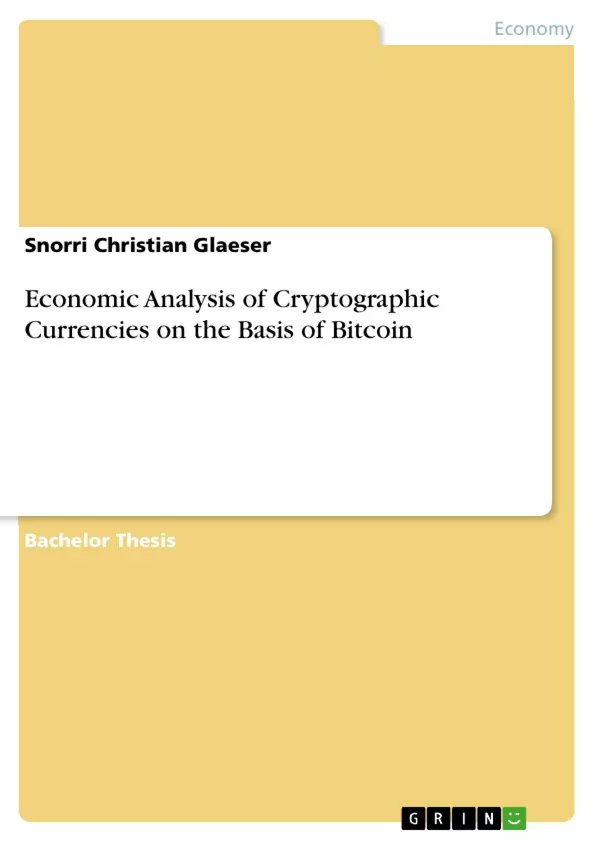Cryptocurrencies have gained increasing attention in the recent years. Especially Bitcoin is on his way from being a very little known phenomenon towards becoming a seriously recognized player in the economy. Its origin lies in the subprime mortgage crisis of 2007 after which crypto anarchists attempted to take the matter of money distribution in their own hands. In 2013, most people still didn’t know what the term Bitcoin is associated with. In a survey, conducted by a German newspaper, 51% of the interviewed persons couldn’t identify Bitcoin. The other half has heard about Bitcoin but could not give further explanation except of identifying it as a virtual cyber currency. There exists a great need for enlightenment about cryptocurrencies such as Bitcoin.
Cryptocurrencies are often associated with the Wild West, as there are still lots of open questions concerning its nature juristically, economically and tax status. The price of a Bitcoin has been growing with recurrences of high fluctuations in the last years and has shown similarities to the concepts of a speculative Bubble. Is this statement justified?
The media either praises Bitcoin as a great innovation, or demonizes it. This makes it very difficult to obtain an objective position about Bitcoin. This work analyses the characteristics of Bitcoin and evaluates their relevance for a sustainable existence. Are cryptocurrencies just a temporary phenomenon or should we expect them to prevail in the future?
The intention of this work is to provide an economical analysis of cryptocurrencies by investigating its biggest representative, Bitcoin. The main research questions are therefore:
• How does Bitcoin work?
• What are the benefits and risks of Bitcoin?
• How is the price of Bitcoin determined?
• Can Bitcoin currently be identified as money?
• What does the future hold for Bitcoins development?
Inhaltsverzeichnis (Table of Contents)
- Introduction
- Course of investigation
- Information on linguistic usage
- The evolution of money
- Functions of money
- Medium of exchange
- Measure of value
- Store of value
- Characteristics of money
- Creation of money
- The European Central Bank
- Money creation by commercial banks
- Functions of money
- The concept of cryptocurrencies
- The infamous Bitcoin
- History
- How Bitcoin works
- Double spending
- Creation of Bitcoins
- Difficulty
- Mining
- Solo Mining
- Pool Mining
- Time and costs
- Revenue by mining
- Alteration of the Bitcoin protocol
- Characteristics of Bitcoin
- Transaction security
- Transaction fees
- Storage security
- Counterfeit protection
- Anonymity
- Irreversible payments
- Volume of bitcoins
- Forms of trading with Bitcoin
- Wired transfer
- Near Field Communication (NFC)
- QR-Code
- Coins
- Debit cards
- How to acquire bitcoins
- Bitcoin exchanges
- Mining
- ATM machine
- Donations
- Businesses accepting bitcoins
- SWOT analysis
- Strengths
- Weaknesses
- Volatility
- Supply shortage
- Energy Consumption
- Opportunities
- Independent online payments
- Micropayments
- Developing countries
- Threats
- Crime
- Silk Road
- Money laundering
- Botnet
- Risks
- Risk of loss
- Risk of prohibition
- 51% Attack
- Niche currency
- Crime
- Classification of bitcoin
- Taxation
- Comparative Analysis
- Theory of speculative bubbles
- Dutch tulip mania
- Digital gold fever
- Scenario Analysis
- Discussion
- Matter of trust
- The great scheme
- The evil Bitcoin
- The question of questions
- Deflation versus Inflation
Zielsetzung und Themenschwerpunkte (Objectives and Key Themes)
This thesis aims to provide an economic analysis of cryptographic currencies, with a specific focus on Bitcoin. The research delves into the evolution of money, examining its functions and characteristics, and then explores the concept of cryptocurrencies, particularly Bitcoin. The thesis analyzes Bitcoin's historical development, its technical workings, and its economic characteristics.
- Evolution of money and its functions
- The emergence and concept of cryptocurrencies
- Economic analysis of Bitcoin, including its technical aspects and characteristics
- Evaluation of Bitcoin's strengths, weaknesses, opportunities, and threats
- Discussion of the classification and speculative nature of Bitcoin
Zusammenfassung der Kapitel (Chapter Summaries)
The introduction lays out the course of investigation and clarifies the linguistic usage employed throughout the thesis. Chapter 2 delves into the evolution of money, exploring its functions and characteristics, including the creation of money by central banks and commercial banks. Chapter 3 introduces the concept of cryptocurrencies, providing a general overview of this emerging financial system. Chapter 4 examines the infamous Bitcoin, its history, how it works, and its key characteristics. Chapter 5 undertakes a comprehensive SWOT analysis of Bitcoin, outlining its strengths, weaknesses, opportunities, and threats. Chapter 6 discusses the classification of Bitcoin, including its taxation and a comparative analysis with other currencies. Chapter 7 explores the theory of speculative bubbles, using historical examples like the Dutch tulip mania and drawing parallels to the current Bitcoin phenomenon. Chapter 8 provides a scenario analysis of potential future developments related to Bitcoin. Chapter 9 delves into a discussion of key issues surrounding Bitcoin, including trust, its potential for manipulation, and its ethical implications.
Schlüsselwörter (Keywords)
Cryptographic currencies, Bitcoin, digital money, decentralized finance, blockchain technology, mining, transaction security, volatility, speculative bubble, financial innovation, economic analysis, SWOT analysis.
- Citation du texte
- Snorri Christian Glaeser (Auteur), 2014, Economic Analysis of Cryptographic Currencies on the Basis of Bitcoin, Munich, GRIN Verlag, https://www.grin.com/document/283747



